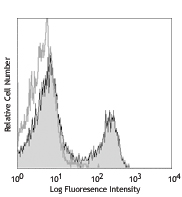- Regulatory Status
- RUO
- Other Names
- Cell Stimulation Cocktail, PMA/Ionomycin
- Ave. Rating
- Submit a Review
- Product Citations
- publications

-

Human peripheral blood lymphocytes were stimulated with Cell Activation cocktail without Brefeldin A for six hours, then surface stained with CD3 APC and CD154 (clone 24-31) Brilliant Violet 421™ (top) or CD25 (clone BC96) PE (bottom). -

| Cat # | Size | Price | Quantity Check Availability | Save | ||
|---|---|---|---|---|---|---|
| 423301 | 100 µL | 72€ | ||||
| 423302 | 400 µL | 212€ | ||||
Cell Activation Cocktail (without Brefeldin A) is a pre-mixed cocktail with optimized concentration of PMA (phorbol 12-myristate-13-acetate) and ionomycin. Activation of cells by PMA and ionomycin leads to an increase in cell surface expression of certain markers such as CD69 and CD154, which can be detected using this cocktail.
Product DetailsProduct Details
- Preparation
- Cell Activation Cocktail (without Brefeldin A) is composed of PMA and ionomycin.
- Concentration
- Each vial of this cocktail contains phorbol-12-myristate 13-acetate 40.5 µM (25 ug/mL) and ionomycin 669.3 µM (500 ug/mL) in DMSO (500X).
- Storage & Handling
- Store cocktail at -70°C upon receipt. Protect from light. Avoid repeat freeze/thaw cycles.
- Application
-
Activ, FC, ICFC - Quality tested
- Recommended Usage
-
Cat. No. 423301 contains 100 µL of cocktail, formulated at 500X, that can be used for activating 50 mL of cells of various types.
Cat. No. 423302 contains 400 µL (4 vials x 100 µL per vial) of cocktail, formulated at 500X, that can be used for activating 200 mL of cells of various types. - Application Notes
-
Cell Activation Protocol:
1. Resuspend cells of interest in desired cell culture medium. Recommended cell suspension is between 1-2 x 106 cells/mL, although effective activation can be obtained with higher or lower concentration.
2. Completely thaw vials in 37°C water bath.
3. Add 2 µL of the cocktail to each mL of cell suspension.
4. Incubate cells at 37°C in a CO2 incubator for 6 hours or the time period of interest.
5. Harvest activated cells and centrifuge at 350g for 5 minutes. Discard supernatant.
6. Add 2.5 mL of Cell Staining Buffer (Cat. No. 420201) to the cell pellet, mix by vortex or pipetting, then centrifuge at 350g for 5 minutes. Discard supernatant.
7. Repeat step 6.
8. Cells are now ready to be tested for surface markers or proteins of interest.
Note: If investigators are interested in detecting intracellular proteins following activation, this product can be used in conjunction with Monensin (Cat. No. 420701) or Brefeldin A (Cat. No. 420601).
This product is temperature sensitive; repeated freeze/thaw is not recommended.
Intracellular and surface flow staining, as well as ELISA, can be performed following activation of cells with this cocktail. - Additional Product Notes
-
View more applications data for this product in our Scientific Poster Library.
- Product Citations
-
Antigen Details
- Gene ID
- NA
Related Pages & Pathways
Pages
Related FAQs
- The Brefeldin A solution freezes at 4°C . Is the solution still OK?
-
We recommend to thaw in warm water after removing from the fridge. The Brefeldin A is dissolved in DMSO, which freezes at 18°C, so this is normal. No one has reported any problems with the freeze/thaw cycles and this is how we recommend it is stored. If customers are concerned, they can aliquot the Brefeldin A to avoid the freeze thaw.
- How do I choose monensin or Brefeldin A solution?
-
Generally, Brefeldin A is more toxic for longer term incubations, so for shorter stimulations (6 hrs or less) use Brefeldin A. For longer stimulations use monensin. We recommend optimization for each cell type and protocol.

 Login / Register
Login / Register 












Follow Us